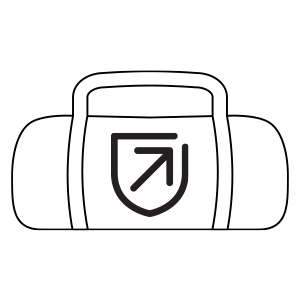- Take time to plan your route
- Test your device's battery-life
- Use massage or recovery tools to release tension
- Don't forget to rest and taper, and
- Keep your race day rituals alive.
Plan your route
Since you'll be racing your own virtual race, you won't have the luxury of a designated course featuring closed roads, on-course marshalls, toilets, first aid and drink stations.
So, you'll need to plan ahead and choose a familiar route that's long enough to cover your chosen distance and one that includes drink/toilet stops along the way. If that's not an option, you can always carry a hydration pack to ensure you stay hydrated.
Depending on your chosen distance, you might need to do a few loops or out and backs near your home.
Test out a few different routes ahead of race day and choose one that will meet all your needs.
Power up
Your virtual race day results are likely to be determined and verified by:
- GPS using a race day app
- submitting a .gpx file, or
- by sharing a link to your GPS watch / Strava activity
This means, you'll need to think about battery power to ensure your device or watch can last the duration of your race.
If you're using a GPS watch, it should have a long enough built-in battery life to last longer race distances such as a half marathon, marathon or ultra. You'll just need to make sure it's fully charged for race day.
If you're using an app on your mobile phone, it's a good idea to test your phone's battery power to make sure it can hold out for your entrie run –especially if you're likely to be out there for a couple of hours.
Remember – the app you're using to track you run as any other apps you're using (such as Spotify) will drain your battery power pretty quickly, so you might need to consider carrying a power bank in your run belt.
Lose the tension
Tension be gone!
You've likely been sitting more than usual in the past few months (and perhaps not on the best chair).
That, on top of all your training, means your muscles will be in a need of some relief. Booking in for a couple of remedial massages will truly do wonders for your body ahead of (and after) race day and keep you injury-free.
Grab yourself a trusty foam roller, hand roller and/or sensory balls and top your massage off with some regular at-home recovery. This will be a helpful part of your training program as the release will help improve recovery and help you feel better while running.
Stress can also impact your training, so scheduling in a massage will provide you with some well-deserved relaxation time to calm your mind and unwind.
Embrace rest day and don't forget to taper
The power of a rest day shouldn't be overlooked and is a crucial part of your training and recovery.
Follow a training program to ensure your body is well-prepared for your chosen distance and that you don't cram – both of which will help you prevent injury. As a general rule, you should complete the most kms at least 3 weeks before race day.
- If you're running an ultra or a marathon, you'll want to start reducing your training load 3 weeks ahead of race day.
- If you're running a half-marathon, you'll want to start reducing your training load 1-2 weeks ahead of race day.
- If you're running a 10K or 5K, you'll want to start reducing your training load 1 week ahead of race day.
As race day approaches, book in for that remedial massage (you deserve it after all), get some sleep, listen to music and/or spend some time in the water.
During race week – you'll want to stay off your legs as much as possible, watch your nutrition closely, stretch (or do yoga), and drink lots of water.
Keep your rituals alive
Just because you won't be lining up at the start line with other runners, doesn't mean you can't keep your own race-day rituals alive.
Here are some tips to help you get the most out of your virtual race day.
Our golden rule – never try anything new on race day – this means nutrition, footwear, and apparel!
- Join online or local clubs to train alongside other runners (check if your event has a dedicate Strava Club).
- Download the race day app (if there is one).
- Print your virtual race bib.
- Lay out all of your clothing and accessories ready to go the night before – including your race bib and watch (don't forget hair ties, anti-chafe and/or band-aids).
- Have your breakfast ready to go.
- Participate in any pre-race breifing or activities (such as warm ups) planned by the race organiser.
- Choose a physical "start line" and "finish line".
- Count yourself down to the race start time (or have a friend/family member do it for you).
- Organise a cheer squad to cheer you on along the way and at the finish line.
- Snap a pic (or several), share it on your social media and celebrate your achievements with friends and family – don't forget to use the event hashtag and the to tag the organiser.
- Submit your results and keep checking the leaderboard to see how you've placed.
- Show off your race day bling!




















